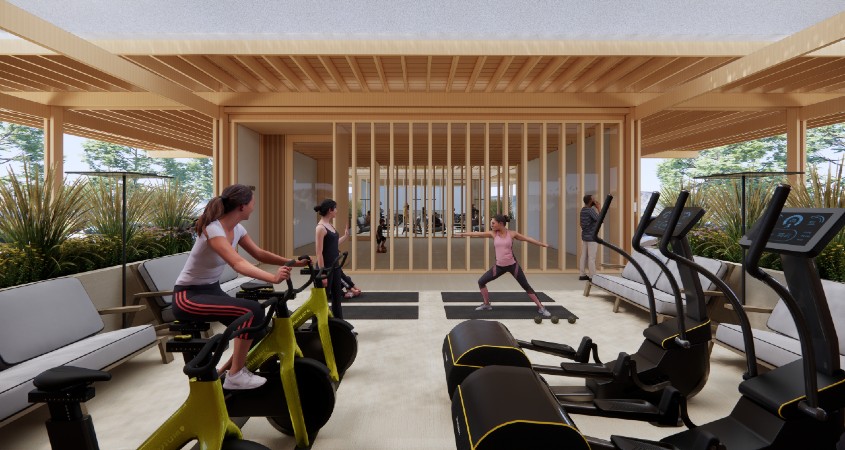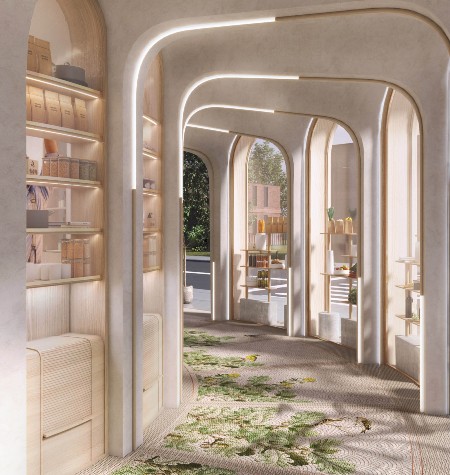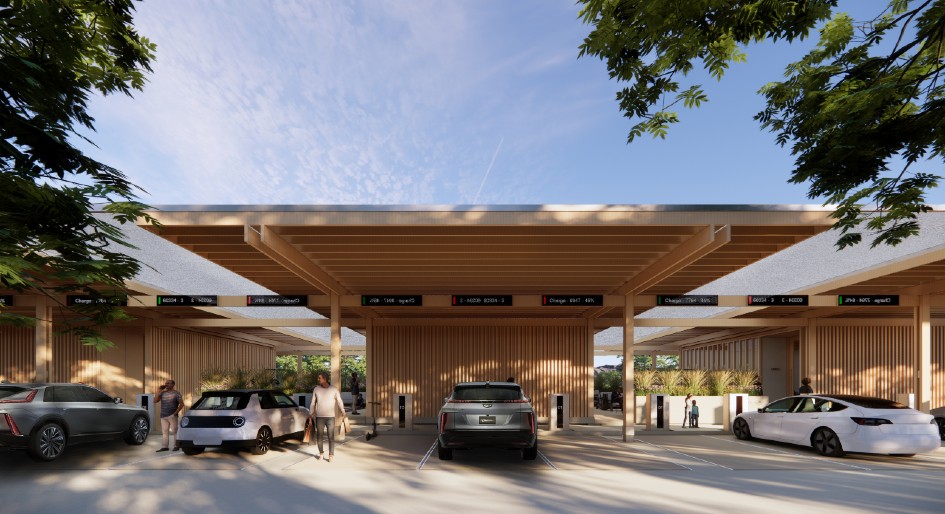Shopping has conventionally been tied to consumer need or desire for material goods, but retailers are now considering how people spend their time, not just the money in their pockets. New theories centre on how experiences, convenience and a sense of community can draw people to a physical site.
A seminar earlier this year at the Toronto Interior Design Show tackled some of those issues. Electric vehicle charging stations, omnichannel shopping and better use of outdoor spaces were all flagged as potential influences.
Roadside reimagining
Ilana Weitzman, Vice President of Strategic Development at Electric Autonomy Canada, identified the transition to electric vehicles and associated evolving travel patterns as a prompt for new designs. Gas stations along the highway have mostly been stop-and-go spots where people fuel up within five minutes, whereas charging can take 20 to 40 minutes.
“These vehicles now have a range of 480 kilometres, but you do need to rest and stop, and where do you do that? This is an incredible opportunity to completely reimagine what that could look like,” she observed.
With this in mind, Electric Autonomy co-sponsored a global architecture competition for a purpose-built roadside oasis for EVs. Scottish architect James Silvester submitted the winning design concept, “More With Less,” featuring inner courtyards for relaxation and a timber-framed canopy that hangs over charging zones to shelter cars and people from harsh elements.
“You can imagine, if you’re getting out of one of these vehicles with a dog or toddler, how much more comfortable it is to not have to cross a vast parking lot along your way,” Weitzman suggested.

In the design, “More with Less,” the EV-fueling station is also a place to relax and enjoy. Photo courtesy of Electric Autonomy Canada.
Silvester’s design will be built in the next two years by the Canadian convenience store operator and independent fuel retailing company, Parkland Corporation, the competition’s other co-sponsor. The design is also modular so it can also be scaled to other types and sizes of retail venues.
Other concepts submitted to the competition integrated outdoor public spaces, incorporated rooftop solar to augment the power supply, or included leisure space with shopping pavilions, stations to view internet streaming and somewhat more upscale restaurants than a gas station’s typical fast-food offerings. Meanwhile, the transition to EVs is expected to broaden the base of fuel retailers since it will no longer be tied to the storage and dispersal of flammable substances containing hydrocarbon contaminants.
“We’re not just talking about the vehicles themselves. We’re talking about the built environment and how that built environment is going to change, adapt and pivot for this new technology,” Weitzman asserted. “Now, smart retailers can get into this space.”
Omnichannel collisions
Stanley Sun, design principal and co-founder of Mason Studio, sketched out the potential for mobile retail and how it might bridge bricks-and-mortar with online purchasing, while filling a community support function. It’s part of an ongoing effort, undertaken with his studio partner, Ashley Rumsey, to explore how physical spaces can create enhanced experiences for omnichannel shopping.
For example, the Calgary retailer, Fresh Fruits, has re-purposed retired city buses to take purchasing opportunities to areas of the city that lack physical food retailers or segments of the population that don’t have access to online shopping. As well, Sun proposes underused parking lots as venues for pop-up retail and “curated windows” from which passersby could choose and order products.

A resilient retail experience by Mason Studio.
“When you’re scrolling your phones, as you’re lying in bed shopping, what is that physical experience around you to actually facilitate that?” Sun mused. “Right now, we are talking about digital environments, but you’re also in a space, so how do we create spaces that actually facilitate digital interactions?”
The design partners envision what they term the “omnichannel collision” through spaces that offer connections to retail, but not necessarily in an explicit way. That space could also help create social and community connections — drawing people into a situation where they can talk about their needs and preferences, and discover common objectives.
“Retail has so much more value than we are giving it,” Sun maintained. “It’s an opportunity to bind people. It becomes the social glue and an opportunity for collision.”
Shopping centre shift
Demalling is the buzzword for transforming and reanimating shopping centres. Supreet Barhay, principal at WZMH Architects, shared some examples from her firm’s work.
That includes Promenade Shopping Centre, located in the Thornhill suburb of Toronto’s neighbouring city, Vaughan, where a phased intensification project is slated to add 18 infill residential/mixed-use towers over the next 20 years. Within Toronto city boundaries, Shops at Don Mills — the now teenaged redevelopment of a former enclosed mall into an open-air concept — represents another future-proofing option.
“Shopping centres are becoming new community hubs,” Barhay remarked.
At Shops at Don Mills that’s seen in summer concerts, winter skating and the many restaurants that pull in local patrons. Yet, where demalling is not necessary or feasible, shopping centres are still evolving with changing times and consumer demands.
Barhay suggests food and experiential retail have become even more of an attraction as society eases out of the COVID-19 pandemic and many mall operators are expanding what was conventionally about 15 to 18 per cent of the retail offerings. They are also harnessing digital technologies to gather more insight into shoppers’ routines and preferences, and to offer a new range of services.
For example, WZMH Architects recently partnered with Microsoft Research’s Urban Futures Workshop through its Sparkbird innovation lab to retrofit a portable trailer where neighbourhood residents can directly learn about their local air quality. Wayfinding apps also help shoppers effectively use their time, providing route guidance and real-time information about store occupancy levels.
Other trends are carryovers from the pandemic when empty parking lots became catalysts for outdoor commerce and engagement such as drive-through entertainment, food trucks with temporary seating or a hub for pick-up and return of products. Parking lots might also contribute to the mall’s energy supply, such is now being tested in a demonstration project where solar canopies integrated with battery storage have been installed.
Barhay cited a Deloitte survey on post-COVID attitudes that found customers are increasingly looking for green features. They want biophilic designs, good air quality and natural light. They also want to see more local Canadian products and parking options for bikes and EV chargers. She suggests there could be positive results from welcoming bike paths to traverse the site and positioning the mall as a destination on those routes.
“Creating variation will attract customers back into the shopping centres,” Barhay submits. “We need to take it to a completely different level.”
Feature photo: Architect James Silvester imagines the electric fueling station of the future. His design, “More with Less,” received first place in Electric Autonomy Canada’s global competition.






Excellent post. I was checking continuously this blog and I’m impressed!
Very impressive…The idea you have shared is really nice that make people more active and connected during shopping.
Excellent!